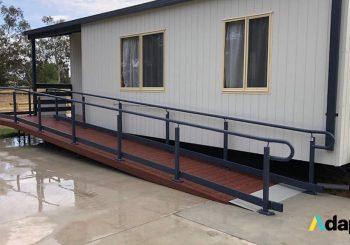Home renovations are done for different reasons — usually for upgrades such as a garage, to add more rooms, to accommodate more furnishings, and to increase accessibility. For households with elderly living independently, adaptive home renovations are often done to create a safer home. These are often done through ramp, handrail, and fence installations.
Benefits of Ramps for the Elderly
According to The Royal Commission, more than 80 percent of Australians prefer to live independently at home as they get older, with more than 200,000 Australians accessing the Commonwealth-funded home care packages. Living independently with full mobility also helps the elderly maintain their confidence and overall quality of life.
In this setting, safety concerns often arise including tripping and falling down stairs. With this, a need to create accessible and safe spaces is rising too. Ramps and handrails for the elderly and people with disabilities are great home additions to address this.
Types of Ramps
There are different types of ramps available depending on the needs of the elderly individual, preferences, expected duration of use, and physical characteristics of the site where it will be installed. These include:
- Portable Ramps: These are lightweight, movable ramps often made of aluminium. Designed to be easily transported and set up as needed, portable ramps often can also be folded or rolled up for easy storage. These are perfect to use while traveling, or during occasional visits to places that are not wheelchair accessible or for short-term rehabilitation.
- Modular Ramps: These are semi-permanent ramps that are made of pre-fabricated sections, often designed particularly for a specific space where permanent installation is not feasible. Modular ramps are more robust than portable ramps and can be adjusted, expanded, and readjusted as needed. These are great for medium-term use or when design flexibility is necessary.
- Permanent Ramps: These are ramps built-on site, designed to last, and integrated within the home design. Usual materials include concrete, wood, and metal. Permanent ramps are great for places that require consistent and reliable access for the long term. It is also recommended for homeowners looking to have a permanent accessibility solution that matches their home design.
Key Design and Legal Considerations
In designing ramps for a home renovation, there are design and legal considerations necessary to keep in mind. These include standards from the AS 1428.1 (Design for access and mobility, Part 1: General requirements for access – New building work) and AS 1428.2 (Specialist Disability Accommodation Design Standards, Livable Housing Design Guidelines):
- Gradual access slope for safe and easy mobility
- Safety features compliant with Australian standards on handrails, non-slip surfaces, and edge protection
- Australian Standard wheelchair access width and length
- Weather considerations such as rain, snow, sun, and how it affects the ramp material and design
Conclusion
In selecting the right ramp, consider the elderly individual’s long-term needs and the home’s physical setup. Each type of ramp offers unique benefits, ensuring enhanced mobility and safety. It’s crucial to prioritise accessibility for our loved ones. Evaluate your needs today and invest in the right ramp for a safer tomorrow.
Adapta Ramps have been creating custom ramps, rails, or steps for the specific needs of Australians for over 20 years. Contact Adapta today to learn more.



